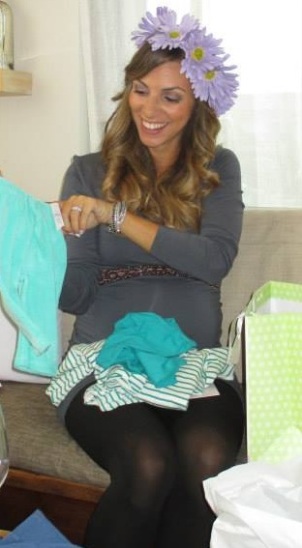 When first finding out that you are expecting a baby, a rush of thoughts and emotions runs through your mind. On the top of the list is usually the issue of sleep. Most expectant parents are listening to horror stories from a friend, or worrying themselves sick with the “what if’s?” Well, let me ask you this, what if you prepared yourself and your baby for sleep instead of anticipating not getting any?
When first finding out that you are expecting a baby, a rush of thoughts and emotions runs through your mind. On the top of the list is usually the issue of sleep. Most expectant parents are listening to horror stories from a friend, or worrying themselves sick with the “what if’s?” Well, let me ask you this, what if you prepared yourself and your baby for sleep instead of anticipating not getting any?
Instead of wasting time worrying about how you will function on little to no sleep, or what your child’s temperament will be, use that time to meet with a professional and learn about infant sleep. A sleep lesson is a great place to start! As a sleep consultant, one of my favorite consultations is what I call the “new parent tutorial.” This is a consultation that I have with expectant parents about 4-6 weeks before their child is scheduled to be born.
Child, Parents, and Expectant Parent
Co-Sleeping
The first issue I address is where parents plan for their baby to sleep. While some parents practice co-sleeping, other parents prefer to have their own sleeping space. There is no right or wrong answer, although there are opinions.
What I help my clients understand is that if they chose to bed share, they need to do it from the beginning and continue until they have a plan in place to properly transition the child into their own environment. This makes the transition less scary for both the parents and the child.
Dr. William Sears is one of the authors of The Baby Sleep Book, which is a great resource for families who choose to bed share. His book explains the findings of many recent studies that show the benefits of sleeping with your child.
The one I found most eye-opening was a study conducted where a baby who normally co-slept with her mother had her breathing monitored two nights in a row. The first night the baby co-slept as usual with her mother, and the following night the baby was put alone in a crib for the entire night, only having contact with her mother when she came in to nurse periodically throughout the night.
The Mother’s name was Martha, the daughter, Lauren. The study revealed that “Lauren breathed better when sleeping next to Martha than when sleeping alone. Her breathing and heart rate were more regular during shared sleep, and she experienced fewer “dips” (low points) in respiration and blood oxygen from slower breathing episodes. On the night Lauren slept with Martha, there were no dips in her blood oxygen, whereas on the night Lauren slept alone, there were 132 dips.”
Develop a Soothing Bedtime Routine
A soothing bedtime routine is essential to helping newborn babies find the rest they deserve. For parents who do not chose to bed share, a soothing routine can be even more important. In the middle of the night when we are awoken by our crying baby, being thrust from a deep sleep and filled with emotions can influence us to do what is easiest and quickest to help our baby and ourselves get back to sleep.
What I encourage parents to understand is that while bed-sharing is an option and can be done healthily, reactive bed-sharing is not ideal and should be avoided. Reactive bed-sharing is when the parent who did not plan to share a bed with their infant, takes their crying baby into bed with them in order to get them to fall back asleep. This is using bed-sharing as a way to correct the child’s behavior and can cause confusion and lead to a reversal in the process of teaching your child healthy sleep habits.
In the first four months, our babies are unpredictable as their eating and sleeping habits are not yet scheduled. This is the time to bond with your baby and establish a healthy soothing routine. Learning what tactics help your baby to relax and drift off to sleep will start your child out on the right path toward healthy sleep.
Remember, even though a baby is tired, they do not know how to fall asleep; parents need to teach their babies how to do so. Enjoy this time with your child as it is very precious, and don’t focus on trying to schedule sleep earlier than is tolerable for your child.
At 16 weeks, a full-term baby is ready to start having scheduled sleep periods. Longer stretches of night sleep will be the first solid period to occur, and certain milestones serve as a warning that there is about to be a change in sleep behaviors. After that is established, the morning nap gets scheduled. The afternoon nap and the third nap will follow. Soon your child will start off on a scheduled, predictable, and appropriate sleep routine.
When it comes to a soothing routine, some important factors to remember are to try out new and different strategies. One parent might have one way of soothing and it may be completely different than the other parent, and that is perfectly acceptable; the most important factor of a soothing routine is timing!
The idea is to start the soothing routine so that the baby is put in their crib, drowsy but awake, at the same time as his biological sleep wave. This takes practice and not all babies have the same amount of tolerance when it comes to wakeful periods. Some newborns can handle two hours of wakefulness, while others can handle only one hour.
It is also important to keep in mind that if your child can handle about 1.5 hours of wakefulness, then you will start their soothing routine after they have been awake for one hour. You don’t want to start the routine when the child starts to melt down from being overtired. Watch your child more than you watch the clock and respond to their sleep signs or “signals” that they are sending to you and letting you know it is time to begin soothing them to sleep.
Colic and Fussy Time
I wanted to address the issue of “colic” and “fussy time” because much like sleep, these are often the other prominent fears among expectant parents. Colic is feared by many but few understand what it truly is and how long it lasts. Colic is the tightness of muscles that surround the baby’s gut which often provides discomfort.
By four months of age, these muscles start to loosen and Colic no longer becomes an issue. I often work with clients who tell me that their child must have the worst case of “Colic” because all their baby does is cry, when in actuality, their child is exhausted due to an unhealthy sleep pattern and the issue of Colic ended when their baby reached 16 weeks of age.
Another term that parents and professionals use is “fussy time” This is the period of time that occurs in the evening and there are several factors that influence it. First, this is the time that our homeostatic drive and our circadian rhythm conflict with one another, leaving the baby in a tired, yet alert state of mind.
This fussy time starts to wear off as our homeostatic drive begins to overpower the circadian rhythm and produces melatonin preparing us for night sleep. For younger infants, fussy time occurs due to the lack of maturity of their brain and nervous system. As the baby develops and their brain matures, “fussy time” starts to taper away.
A fussy period of time commonly occurs at six weeks of age, or for premature babies, six weeks from their expected due date. Dr. Weissbluth addresses this issue and states “Paroxysmal fussing in infants sometimes called ‘colic’ is usually described as an unsettled, agitated, wakeful state that would lead to crying if ignored by parents.
Because sucking is soothing to infants, some parents misattribute the ‘fussing’ state to hunger and vigorously attempt to feed their baby. These parents may misinterpret their infants as having a ‘growth spurt’ at six weeks because they were ‘hungry all the time, especially in the evening. They view their child as hungry, not fussy.” This is the reason that studying your baby’s signals and learning their sleepy cues are essential to figuring out the difference between when they are tired and when they are hungry.
The best thing you can do as a parent is trying to be prepared and knowledgeable about each phase of sleep. Remaining a step ahead of the curve will produce stability in your family’s sleep, and you will not be caught off guard.
Sears, William, Robert Sears, and Martha Sears. The Baby Sleep Book: How to Help Your Baby Sleep and Have a Restful Night. London: Thorsons, 2005. Print.
Sears, William, Robert Sears, and Martha Sears. The Baby Sleep Book: How to Help Your Baby Sleep and Have a Restful Night. London: Thorsons, 2005. Print.
West, Kim, and Joanne Kenen. The Sleep Lady’s Good Night, Sleep Tight: Gentle Proven Solutions to Help Your Child Sleep Well and Wake up Happy. New York: Vanguard, 2010. Print.
Weissbluth, Marc. Healthy Sleep Habits, Happy Child: A Step-by-step Program for a Good Night’s Sleep. New York: Ballantine, 2005. Print.
Ferber, Richard. Solve Your Child’s Sleep Problems. London: Vermilion, 2013. Print.
As seen on SleepJunkies.com February 2014

Comments 12
Pingback: levné kamagra přes noc
Pingback: xifaxan without rx
Pingback: cheap rifaximin no prescription overnight delivery
Pingback: discount staxyn generic pricing
Pingback: get avodart australia cheap
Pingback: canadian pharmacy for ed drugs itraconazole
Pingback: get fildena generic pharmacy in canada
Pingback: cheapest buy gabapentin purchase generic
Pingback: order flexeril cyclobenzaprine without recipe
Pingback: Buy androxal online without a perscription
Pingback: purchase enclomiphene usa price
Pingback: magasin de tapis sun d low cost kamagra